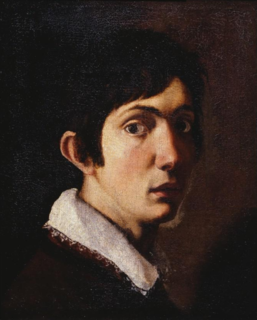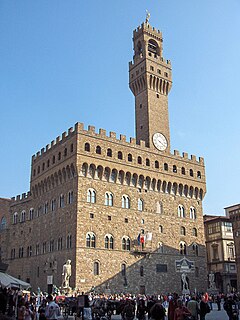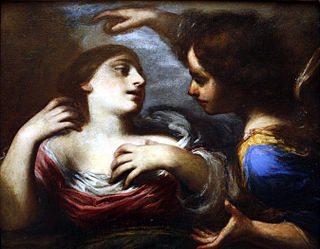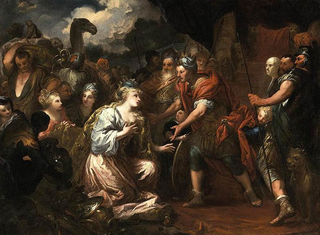
| Wikimedia Commons has media related to Simone Pignoni . |
Simone Pignoni (April 17, 1611 – December 16, 1698) was an Italian painter of the Baroque period.

Italy, officially the Italian Republic, is a country in Europe. Located in the middle of the Mediterranean Sea, Italy shares open land borders with France, Switzerland, Austria, Slovenia and the enclaved microstates San Marino and Vatican City. Italy covers an area of 301,340 km2 (116,350 sq mi) and has a largely temperate seasonal and Mediterranean climate. With around 61 million inhabitants, it is the fourth-most populous EU member state and the most populous country in Southern Europe.

The Baroque is a highly ornate and often extravagant style of architecture, music, painting, sculpture and other arts that flourished in Europe from the early 17th until the mid-18th century. It followed the Renaissance style and preceded the Rococo and Neoclassical styles. It was encouraged by the Catholic Church as a means to counter the simplicity and austerity of Protestant architecture, art and music, though Lutheran Baroque art developed in parts of Europe as well. The Baroque style used contrast, movement, exuberant detail, deep colour, grandeur and surprise to achieve a sense of awe. The style began at the start of the 17th century in Rome, then spread rapidly to France, northern Italy, Spain and Portugal, then to Austria and southern Germany. By the 1730s, it had evolved into an even more flamboyant style, called rocaille or Rococo, which appeared in France and central Europe until the mid to late 18th century.
He apprenticed with Fabrizio Boschi, then with the more academic and puritanical Domenico Passignano, and finally with Francesco Furini. He is best known for painting in a style reminiscent of the morbidly sensual Furini. Reflective of this obsession is his self-portrait, c. 1650, in which he depicts himself building up a plump naked female from a skeleton. The biographer Baldinucci, in what little he notes of the painter, recalls him as the scandalous "imitator of (Furini's) licentious inventions".

Fabrizio Boschi (1572–1642) was an Italian painter of the early-Baroque period, active in Florence.

Domenico Passignano, born Cresti or Crespi, was an Italian painter of a late-Renaissance or Counter-Maniera (Counter-Mannerism) style that emerged in Florence towards the end of the 16th century.

Francesco Furini was an Italian Baroque painter of Florence, noted for his sensual sfumato style in paintings of both secular and religious subjects.
A more complete biography was recorded by his pupil Giovanni Camillo Sagrestani. Described as endowed with a "bizarre and amenable intelligence", Pignoni apparently had a late-life conversion to more pious painting. There is one episode recalled that during a serious illness "because in his life he had focused on studying about female forms, and (now) having resigned himself to the impending infinity, his spiritual father urged him to purge those errors with the flame, and once guided by a good disposition, he suddenly was cured by the Lord." Baldinucci's biography of Furini also recorded a similar, near-death renunciation of his art of the naked figure.

Giovanni Camillo Sagrestani (1660–1731) was an Italian painter of the Baroque era.
Among his more conventional works are a St. Agatha cured by St. Peter (attributed) in the Museo Civico di Trieste; a St. Louis providing a banquet for the poor (c. 1682) now in the church of Santa Felicita in Florence, commissioned by Conte Luigi Gucciardini; and a Madonna and child in glory with archangels Saints Michael and Raphael in battle armor and San Antonio of Padua (1671) for the Cappella di San Michele in Santissima Annunziata. He painted an Allegory of Peace in Palazzo Vecchio. A Penitent Magdalen that has been attributed to Pignoni is found in the Pitti Palace. In San Bartolomeo in Monteoliveto, he painted a Madonna appearing to Blessed Bernardo Tolomeo.

Trieste is a city and a seaport in northeastern Italy. It is situated towards the end of a narrow strip of Italian territory lying between the Adriatic Sea and Slovenia, which lies almost immediately south and east of the city. It is also located near Croatia some further 30 kilometres (19 mi) south.

The Palazzo Vecchio is the town hall of Florence, Italy. It overlooks the Piazza della Signoria with its copy of Michelangelo's David statue as well as the gallery of statues in the adjacent Loggia dei Lanzi.

The Abbey of Monte Oliveto Maggiore is a large Benedictine monastery in the Italian region of Tuscany, 10 km south of Asciano. Its buildings, which are mostly of red brick, are conspicuous against the grey clayey and sandy soil—the Crete senesi which give this area of Tuscany its name.
In addition to Sagrestani, another pupil was the priest Luca Querci of Cutigliano. [1]

Cutigliano was a comune (municipality) in the province of Pistoia in the Italian region Tuscany, located about 50 kilometres (31 mi) northwest of Florence and about 25 kilometres (16 mi) northwest of Pistoia. It has been a frazione of Abetone Cutigliano since 2017.















